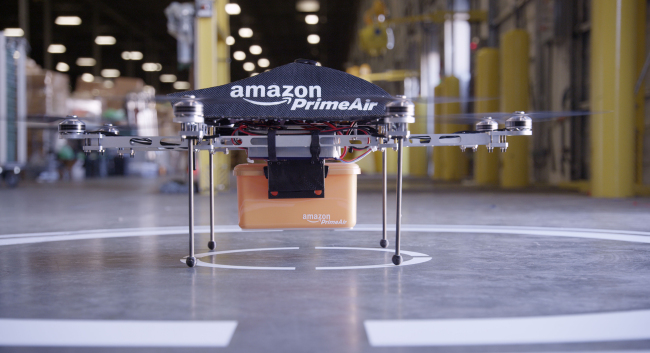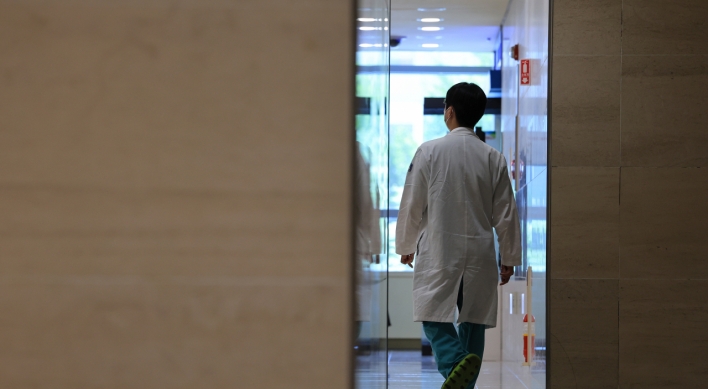[Weekender] Drones for delivery?
Robotics-based service plans confront technical, legal, privacy concerns
By Yoon Min-sikPublished : Jan. 10, 2014 - 20:24

A drone-based delivery system currently under development has raised hopes for faster, more efficient services, but concerns over its feasibility linger due to legal and technical limitations.
A series of major global firms such as Amazon have recently revealed their prototype services, which aim to reduce delivery time and labor costs to increase profits. But challenges such as safety concerns, logistics and potential invasion of privacy remain.
Experts express concerns about flying drones in populated areas. “You’re putting a device with eight rapidly spinning blades into areas where people are assumed to be,” said Matt Waite, a journalism professor at the University of Nebraska. He said that the drones present a “significant threat” to people on the ground.
The new system is also strained by logistics. For example, Amazon’s drones are only able to travel up to 16 kilometers, which means the company would have to spend a massive amount of money on building distribution centers in urban areas.
Marcus Wohlsen from the U.S. tech magazine Wired pointed out that even if the company expanded the drone’s range, it would be inefficient to have drones a fly long distance to make a solitary delivery.
Ralph Rio of the market research firm ARC Group, however, said that the drone technology would not replace delivery trucks, but augment them. According to his scenario, a delivery truck carrying drones would arrive at a certain area and release the drones, which would then deliver packages to customers in the area.
Regulations may also hinder the unmanned drone delivery system, as the U.S. Federal Aviation Administration does not allow the use of drones for commercial purposes. The FAA is working to develop operational guidelines on drone use by the end of 2015, but Waite said the rules are not expected to allow for autonomous drones.
If that is the case, a remote pilot will have to control drones at all times, which could generate extra costs.
Fred Smith, the chairman of the U.S.-based delivery giant FedEx, flat out dismissed the idea of drone delivery systems becoming a source of serious competition. He said he found the idea of drones making commercial deliveries “almost amusing.”
Companies looking to use drones to make deliveries will have to be mindful of privacy issues as well. There have been concerns that companies may use drones to collect images of their potential clients.
“Think about how many drones could be flying around the sky. Here a drone, there a drone, everywhere a drone. Who’s watching out for the privacy of American citizens?” said U.S. lawmaker Ted Poe, who introduced a bill designed to prevent individuals and businesses from using drones for photography and other means of surveillance.
Even after all the legal and technological hurdles are cleared, it is unclear whether consumers will feel comfortable with lightweight drones bringing purchased goods to their homes.
“The truth is that no one who buys discounted merchandise on Amazon today will have it delivered by drone, and such deliveries won’t happen for years ― if they happen at all,” Wohlsen said. He added that using drones for deliveries “doesn’t make economic sense” unless a company completely overhauls its mode of operating.
Last month, Amazon caused a stir by announcing that it is working on an unmanned drone-based delivery system. According to the company’s CEO Jeff Bezos, the envisioned “Prime Air” system is able to carry out a “half-hour delivery” of 2-kilogram cargo to customers.
Another U.S.-based company, the United Parcel Service, and Germany’s Deutsche Post DHL are reportedly researching the use of drones for deliveries. On the heels of Amazon’s announcement, DHL ran a test of its “parcelcopter,” which can carry loads of just over 1 kilogram using GPS navigation.
Google is also rumored to be combining its self-driving cars project and the robot technology of its recently acquired Boston Dynamics for package delivery.
By Yoon Min-sik (minsikyoon@heraldcorp.com)











![[Kim Seong-kon] Democracy and the future of South Korea](http://res.heraldm.com/phpwas/restmb_idxmake.php?idx=644&simg=/content/image/2024/04/16/20240416050802_0.jpg&u=)








![[Today’s K-pop] Zico drops snippet of collaboration with Jennie](http://res.heraldm.com/phpwas/restmb_idxmake.php?idx=642&simg=/content/image/2024/04/18/20240418050702_0.jpg&u=)